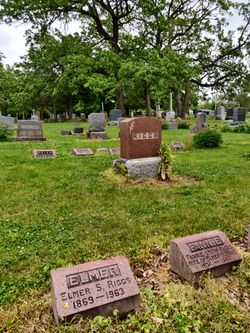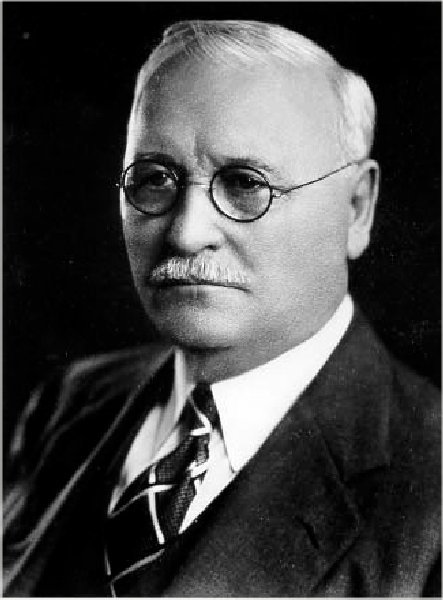Riggs received his bachelor's degree from the University of Kansas in 1896, and along with Barnum Brown, joined the American Museum's fossil collecting expedition that summer. After winning a fellowship to Princeton, Riggs continued his studies that fall under paleontologist William B. Scott. However, concern about continued funding of his studies led him to apply for work at the Field Columbian Museum in Chicago. At the time, the Field Museum was just setting up their paleontology program and Riggs became their first dedicated paleontologist.
Riggs spent three very successful field seasons, 1899-1901, collecting dinosaurs in the Jurassic Morrison formation of Wyoming and Colorado, netting the type specimen of Brachiosaurus altithorax – the largest dinosaur known at the time.
In 1901, Riggs married Helen Mosher, a Chicago schoolteacher, in September 1901, and fathered two sons, Robert and Calvin. He also began publishing descriptions of his specimens in hopes of completing his Ph.D. However, museum paleontology provided only a meager income and for Riggs, persistent financial shortfalls prevented him from finishing his Ph.D., which he gave up after 1905.
Tragically, his wife died in 1906. Feeling unfit to raise two young children on his own, Riggs sent them to eastern Washington live with his brother Robert's family. He saw them very infrequently until after he married Frances Smith in 1913.
In 1921, increased funding reinvigorated scientific work at the Field Museum. Riggs spent most of the next six years doing fieldwork in Canada and South America. The Canadian expedition was devoted to Late Cretaceous dinosaurs and yielded several exhibit-quality specimens. Many unique mammal specimens from the South American expedition are still on display at the Field Museum. His last expedition for the Field Museum was in 1931. He retired in September 1942, after more than forty years of service to the Field Museum.
Riggs moved back to Lawrence, Kansas after his retirement, but remained active in his chosen field by volunteering at the university's museum and joining its students for fossil hunting in western Kansas. His second wife died in 1945. He also continued to lecture, publish and revise old manuscripts. Riggs died at the age of 94 on 25 March 1963, in Sedan, Kansas.
Riggs received his bachelor's degree from the University of Kansas in 1896, and along with Barnum Brown, joined the American Museum's fossil collecting expedition that summer. After winning a fellowship to Princeton, Riggs continued his studies that fall under paleontologist William B. Scott. However, concern about continued funding of his studies led him to apply for work at the Field Columbian Museum in Chicago. At the time, the Field Museum was just setting up their paleontology program and Riggs became their first dedicated paleontologist.
Riggs spent three very successful field seasons, 1899-1901, collecting dinosaurs in the Jurassic Morrison formation of Wyoming and Colorado, netting the type specimen of Brachiosaurus altithorax – the largest dinosaur known at the time.
In 1901, Riggs married Helen Mosher, a Chicago schoolteacher, in September 1901, and fathered two sons, Robert and Calvin. He also began publishing descriptions of his specimens in hopes of completing his Ph.D. However, museum paleontology provided only a meager income and for Riggs, persistent financial shortfalls prevented him from finishing his Ph.D., which he gave up after 1905.
Tragically, his wife died in 1906. Feeling unfit to raise two young children on his own, Riggs sent them to eastern Washington live with his brother Robert's family. He saw them very infrequently until after he married Frances Smith in 1913.
In 1921, increased funding reinvigorated scientific work at the Field Museum. Riggs spent most of the next six years doing fieldwork in Canada and South America. The Canadian expedition was devoted to Late Cretaceous dinosaurs and yielded several exhibit-quality specimens. Many unique mammal specimens from the South American expedition are still on display at the Field Museum. His last expedition for the Field Museum was in 1931. He retired in September 1942, after more than forty years of service to the Field Museum.
Riggs moved back to Lawrence, Kansas after his retirement, but remained active in his chosen field by volunteering at the university's museum and joining its students for fossil hunting in western Kansas. His second wife died in 1945. He also continued to lecture, publish and revise old manuscripts. Riggs died at the age of 94 on 25 March 1963, in Sedan, Kansas.
Family Members
Sponsored by Ancestry
Advertisement
Advertisement














